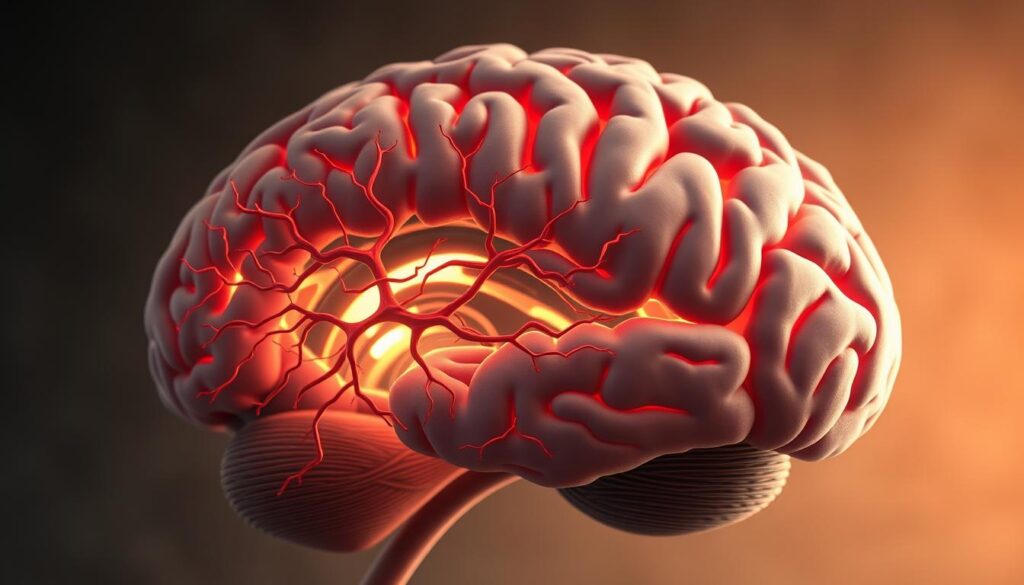Could hormones made inside the brain not just the gonads reshape motivation aggression and decision making?
Local estrogens called neuroestrogens are synthesized on site in many vertebrate brains and tune neural circuits in real time.
Adult teleosts show extremely high aromatase activity, producing brain estrogens even in males. Genetic tools like cyp19a1b mutants reveal that cutting brain estradiol shifts testosterone and 11KT and changes male-typical motivation and aggression.
This page previews how modern behavioral biology reframes brain health by focusing on localized hormone signaling rather than only peripheral endocrine input.
We will walk from classic rodent aromatization to teleost diversity and human relevance, highlighting mechanisms assays, and translational guardrails.
Key Takeaways
- Neuroestrogens act within defined circuits to tune receptors and gene programs.
- High aromatase in teleost brains shows strong local hormone production.
- cyp19a1b mutants help separate brain sourced effects from gonadal hormones.
- New data link local estrogens to motivation aggression, and social choices.
- The article provides practical information for research and translation.
Executive overview present day trends reshaping brain health research
Data from medaka provide a clear trend: local estrogen synthesis in the brain matters for social drive and decision timing. Recent studies show that cutting brain E2 via cyp19a1b mutation lowers male courtship and aggression even when brain androgens rise.
The most compelling signal is simple and strong. Selective impairment of brain estrogen production unmasks control of behavioral vigor and latency. Rescue with estradiol restores courtship initiation frequency and latency but does not rescue aggression under the tested dosing paradigm.
Local hormone balance, not just systemic levels, drives circuit-specific outcomes.
Publication quality datasets hormone quantification in situ mapping, and transcriptional readouts support these conclusions. The report highlights regulation at the receptor and gene program level and flags gaps such as dosing schedules and cross-species alignment.
- Takeaway: targeting local steroidogenic enzymes or receptor expression produces nuanced behavioral effects.
- Future: combine behavioral endpoints with spatial transcriptomics and receptor mapping for higher-resolution information.
What are neuroestrogens? Definitions, sites of aromatase expression and local estrogen action
Brain synthesized estrogens act near their site of formation to tune neural excitability and motivated behavior.
Neuroestrogens are estrogens made inside the brain parenchyma primarily by the enzyme aromatase. Their production creates rapid, local signals that alter synaptic function and circuit output.
The genetics of teleosts illustrate tissue partitioning. Two cyp19a1 genes segregate roles: cyp19a1b shows enriched brain expression, while cyp19a1a concentrates in the gonad. This split confirms that the brain is a distinct site of steroid synthesis.
Regional regulation concentrates aromatase in preoptic and hypothalamic nuclei. Those nuclei control reproduction and social drives, so local estrogen availability directly shapes relevant behaviors.
Local estrogen signaling differs from peripheral hormone action in key ways. Neuroestrogens appear with fast kinetics act within circuit boundaries, and modulate receptor expression and downstream transcription programs on site.
Mechanistically, estrogen receptors for example Esr1 and Esr2 variants bind ERE-like elements to alter transcription in targeted neurons. Selective loss of brain aromatase reduces central E2 without changing peripheral levels validating in situ synthesis as the driver of those central actions.
- Takeaway Site specific aromatase expression enables circuit level control of motivation and social choice.
- Implication Local steroid control is a plausible lever for fine tuning excitability plasticity and motivational states tied to brain health.
From rodent aromatization hypothesis to broader vertebrate diversity
Work in mice firmly established that the brain converts testicular androgens into estrogens via aromatase, and that those estrogens act through ESR1 to shape male typical behaviors.
Key developmental windows require central estrogen signaling to organize circuits while adult estrogenic actions activate repertoire elements such as courtship and territorial displays.
Robust genetic and lesion studies show behavioral necessity in rodents yet the exact downstream molecular mechanisms and circuit targets remain incompletely defined.
Region-specific aromatase and ER expression patterns make outcomes highly context-dependent. ER-driven transcription supports experience- and hormone-dependent plasticity in identified nuclei.
Rodent models provide mechanistic footholds but do not fully predict other vertebrate solutions.
| Feature | Rodents | Other vertebrates |
|---|---|---|
| Primary pathway | Brain aromatization to estrogens | Varies; androgens often dominant |
| Key receptor | ESR1-mediated signaling | Diverse ER and AR profiles |
| Behavioral evidence | Strong necessity for male-typical acts | Mixed; species-specific outcomes |
Positioning rodents as a foundational model helps guide experiments in fish and humans. Still resolving ESR1-linked circuit targets is a priority for translation.
Teleost insights extremely high brain aromatase and surprising behavioral outcomes
High aromatase in many teleost forebrains creates a large local estrogen reservoir that coexists with potent androgens. This biochemical arrangement gives the brain independent control over steroid availability and circuit tuning.
cyp19a1a vs cyp19a1b subfunctionalized gene expression in gonad and brain
Teleosts split aromatase into two paralogs. cyp19a1a concentrates in the gonad while cyp19a1b shows enriched neural expression. That subfunctionalization enables tissue specific production of estrogens and precise local action.
Why 11-ketotestosterone complicates assumptions about estrogen’s role
Many teleosts make 11-ketotestosterone 11KT as the primary testicular androgen. Because 11KT cannot aromatize studies showed it alone can induce male-typical courtship and aggression displays even in females.
Those findings fostered the view that androgens drive male-typical behaviors and that central estrogens were less important. Yet adult fish brains show 100–1000× higher aromatase activity than rodents implying a substantial pool of locally made estrogen.
The data shift the model from either or to dynamic co-action: androgens and local estrogens both shape motivational displays.
- Paradox: strong androgen potency exists alongside massive brain aromatase investment.
- Open question: what circuit level regulation determines when estrogens versus androgens dominate a given behavior?
- Practical note: courtship display metrics are sensitive readouts of motivation and reveal subtle shifts when brain aromatase is altered.
Selective disruption of brain aromatase produces surprising outcomes that challenge simple androgen-only models. The next sections quantify how impairing local estrogen synthesis reshapes motivation aggression, and gene expression.
New data spotlight cyp19a1b deficient medaka reveal neuroestrogen dependent behaviors
Selective impairment of brain aromatase in medaka offers a clean test of central estrogen actions on courtship and aggression.
Study design and genetic control
The team used a nonsense mutation in cyp19a1b to block brain aromatase while leaving gonadal estrogen production intact.
This genetic approach isolates local steroid synthesis and controls for peripheral hormone expression.
Hormone outcomes in the brain
Mutant males showed brain E2 at 16% of wild-type and females at 50%.
Brain testosterone rose ~2.2× in males 11KT rose 6.2× in males and 1.9× in females. Peripheral E2 stayed unchanged, validating site-specific loss.
Behavioral assays and controls
Mating tests recorded longer latencies to wrapping and spawning (P ≤ 0.0195) and far fewer courtship displays and wrapping attempts against unreceptive esr2b-deficient females (P
Group tests showed reduced chases, fin displays circles, strikes, and bites, with significant drops in bites (P ≤ 0.0015). Fertility remained normal ruling out infertility as a confound.
Rescue experiments and interpretation
Systemic E2 shortened display latency and increased display counts in mutants (P = 0.0005; P = 0.0006) but did not restore aggression under the tested regimen.
These data indicate that local estrogens are necessary for full motivational drive and proper escalation to mating acts even when brain androgens rise. The dataset thus serves as a reference for separating motivation from performance in behavioral analysis.
- Genetic control: targeted cyp19a1b nonsense allele isolates brain effects.
- Hormone profile: sharp E2 loss with compensatory androgen increases in the brain.
- Behavioral readouts: delayed and reduced courtship displays; aggression largely unchanged by E2 rescue.
Mechanisms of action how neuroestrogens potentiate androgen receptor signaling
Central estradiol engages estrogen receptors at gene-level motifs to boost androgen receptor transcription where it matters most.
Transcriptional control links estrogen binding to increased ara and arb levels. In silico scans found canonical ERE-like sequences in ara (introns +1699, +2050) and in arb (5′ at −1272, −2180, −3327).
Luciferase assays showed that E2 activates transcription through those sequences when Esr1/Esr2 variants are present. Mutating the ERE-like sites reduced activation, confirming sequence-dependent regulation.
In situ mapping revealed reduced ara in PPa, pPPp, and NVT, and reduced arb in PMp, aPPp, and NPT of mutants. Systemic E2 restored regional expression, showing reversible transcriptional control.
Downstream, androgen-dependent vt in pNVT fell to 18% and gal in pPMp to 43% of wild-type in mutants. These shifts link receptor expression changes to altered neuropeptide outputs and the observed mating and aggression behaviors.
The core mechanisms therefore show that local estrogenic signaling raises AR availability and primes AR-driven gene programs. This potentiation explains why higher androgens alone fail to fully recover motivated action when neuroestrogens are deficient.

- Evidence: motif discovery, reporter assays, and in situ mapping converge.
- Implication: estrogen-dependent transcription gates AR pathways in defined nuclei.
- Next step: map ER subtype occupancy and temporal dynamics during behavioral states.
Neuroestrogens
Local estrogen synthesis within discrete nuclei provides rapid, circuit-specific tuning of motivated states.
Definition and role: Neuroestrogens are estrogens made in the brain by aromatase. They act near their site of production to modulate receptor availability and circuit excitability. This local action shapes social and reproductive behavior in real time.
How they work: Brain estrogens amplify androgen receptor pathways by raising AR subtype expression and by altering neuropeptide gene output. Those molecular shifts change drive, latency, and display frequency in medaka and related teleosts.
Key evidence shows that selective loss of central E2 cuts courtship motivation and reduces several aggression metrics. Systemic E2 can rescue courtship latency and counts but not all aggression features under tested dosing.
Local estrogens act in tandem with androgens to amplify AR pathway effectiveness rather than replace it.
| Feature | Evidence | Behavioral effect | Molecular readout |
|---|---|---|---|
| Site of synthesis | High brain aromatase teleosts | Enhanced motivation | AR subtype upregulation |
| Loss of function | cyp19a1b mutants | Delayed courtship reduced attacks | Lower neuropeptide expression |
| Rescue | Systemic E2 dosing | Faster displays; partial recovery | Restored AR and some gene expression |
Behavioral biology to brain health implications for cognition motivation and social behavior
Local shifts in steroid tone reshape how animals value social rewards and choose actions under pressure.
From male-typical behaviors to motivational states and decision-making
Deficits in local estrogen synthesis lengthen latencies to courtship and cut the number of displays. These changes point to a lowered drive rather than a motor failure.
Reduced aggression and altered vt/gal expression implicate decision nodes that weigh reward and cost. That shift suggests altered action selection during social encounters.
Potential links to cognitive function and neuropsychiatric phenotypes
Changes in preoptic and hypothalamic signaling could affect executive control and impulse regulation. Variability in local steroid production and receptor expression may underlie individual differences in social cognition.
Motivation and social choice appear to be tuned by local estrogenic tone offering precise levers for circuit-level rescue.
| Domain | Evidence | Brain implication |
|---|---|---|
| Motivation | Longer latency, fewer displays | Lower reward valuation |
| Social decision-making | Reduced aggression; vt/gal shifts | Altered action selection nodes |
| Cognitive risk | Behavioral and molecular changes | Possible links to motivational deficits in psychiatric states |
Takeaway: Targeted modulation of local estrogenic tone may restore adaptive social actions without systemic side effects. Combining endocrine readouts with cognitive testing will help map how these molecular changes shape decision making trajectories.
Species matters where rodent fish and human data converge and diverge
The species comparison clarifies both overlap and key differences in hormone control of social action. Rodent work in mice shows strong ESR1-mediated aromatization in the brain that is necessary for several male-typical behaviors.
By contrast primates and humans often rely on direct androgen receptor AR signaling. In those systems, androgens can drive action without extensive aromatization, so translational expectations differ.
Teleosts present a hybrid case. 11KT can elicit male displays via AR, yet recent data show local estrogens can potentiate AR pathways by altering receptor expression and gene programs. This means both routes matter for final behavior.
Androgen receptor dominant pathways in primates and humans
Clinical translation requires mapping AR and ER distributions in homologous nuclei. Where AR dominates, interventions may target AR signaling directly rather than aromatase.
Translational caution aligning site specific expression and receptor subtypes across species
Before generalizing from rodents to humans confirm regional aromatase and receptor subtype expression. Matching baselines receptor availability, and behavioral paradigms is essential for valid cross-species inference.
Acknowledging divergence enhances the precision and credibility of cross-species conclusions.
| Axis | Mice | Teleosts | Primates/Humans |
|---|---|---|---|
| Primary driver | Brain aromatase → estrogens | AR via 11KT local estrogens potentiate | Direct AR signaling common |
| Receptor pattern | ESR1-rich in circuits | Mixed ER/AR high aromatase zones | AR-dominant in many social areas |
| Translational note | Useful mechanistic model | Hybrid insights; comparative value | Map human AR/ER first |
- Design comparative studies that profile aromatase, ER/AR subtypes, and regional controls.
- Use selective enzyme, receptor, and ligand manipulations to test causal roles per species.
- Match hormone baselines and behavioral readouts to keep cross-species comparisons valid.
Regulation plasticity and context how site specific expression drives changes over time
Site-specific aromatase and receptor maps create local steroid niches that reshape circuit responsiveness over hours to weeks.
Localized aromatase and AR/ER expression form microenvironments that tune how a given brain site responds to stimuli. These pockets change receptor availability and set thresholds for motivated actions.
Evidence in medaka shows that systemic E2 can restore Ara and Arb expression in defined nuclei. That reversible regulation demonstrates rapid transcriptional responsiveness and time-dependent plasticity.
Behavioral recovery is modality-specific. Courtship latency and display counts improved with E2 dosing, while some aggression measures required different timing or dose. This shows that circuit thresholds and receptor locales matter.
Context also shapes outcomes. Social setting, stimulus type, and internal state interact with local steroid tone to produce variable behaviors. Longitudinal designs help separate short-term modulation from lasting changes.
Targeted site-directed modulation offers a path to refine motivation or aggression with fewer off target effects.
Practical steps include pairing activity mapping with timelines of receptor expression and testing site-directed delivery. These approaches will clarify plasticity windows across nuclei and guide safe, precise interventions.
- Takeaway: regulation at the site level governs reversible expression and behavior.
- Design note: prioritize longitudinal circuit-specific measures to link molecular shifts to actions.
Data that matter for a trend report assays displays controls and publication quality metrics
Standardized endpoints for latency and act counts improve sensitivity to motivational change across experiments.
Behavioral endpoints should include latency to first courtship display or wrapping, counts of displays per session and a defined aggression score across five acts chases, fin displays circles, strikes, and bites. These measures separate drive from motor ability and make cross-study comparison possible.
Molecular readouts require spatial expression maps and functional reporters. Use in situ hybridization for ara/arb/vt/gal to quantify nuclei-level expression. Pair that with luciferase transcription reporters driven by ERE-like genomic fragments to validate direct ER-mediated transcription.
Controls and analytics
- Include esr2b-deficient females as a behavioral control and perform fertility checks to rule out infertility confounds.
- Report hormone analytics that distinguish brain from peripheral aromatase effects.
- Apply publication-standard stats: Gehan Breslow-Wilcoxon for latency Bonferroni or Dunn post hoc tests, and clear SEM with effect sizes and replication numbers.
Practical recommendation: publish a methods page with standardized definitions for displays, controls, molecular endpoints, dosing timelines, and replication numbers so other labs can reproduce the content and interpret the information reliably.
Opportunities and limitations what current studies can and cannot conclude
This body of work defines clear experimental strengths and important limits for interpreting brain limited steroid control of social actions.
The strongest advantage is precision. Targeted cyp19a1b disruption provides clean genetic control that isolates central hormone effects from peripheral ones.
Behavioral data and spatial molecular mapping converge. Reduced brain E2, raised androgens, and parallel shifts in ara/arb and vt/gal expression form a coherent mechanistic story that links molecular change to altered actions and displays.
Key gaps and limits
- Dosing and timing: systemic E2 rescued courtship latency but not all aggression, indicating dose-response and temporal windows need mapping.
- Aggression rescue: incomplete recovery points to circuit specific thresholds or missing co-factors.
- Cross-species generalizability: AR vs ER dominance differs across vertebrates, complicating direct translation to primates or humans.
Opportunities to advance interpretation
- Map dose-response curves and temporal windows for distinct behavioral domains.
- Combine activity mapping (immediate early genes, functional imaging) with expression assays to link circuits to actions.
- Create a shared website and content repository for standardized protocols, controls, and raw data to improve reproducibility across labs.
- Encourage preregistered, multi-site studies and include cognitive endpoints that test decision-making and social valuation under manipulation.
Precision genetics plus multi-level readouts set a strong foundation targeted replication and cross-species alignment will define translational value.

Conclusion
Disrupting brain-only aromatase in medaka separates peripheral hormones from central control and shows how local signals drive social action.
Neuroestrogens act as pivotal site specific modulators that potentiate androgen pathways by boosting AR subtype expression via ER-mediated transcription. This molecular cascade primes neuropeptide programs and raises circuit excitability needed for full male typical motivation and aggression.
While mice established aromatization as a core idea, teleost data refine it: local estrogens amplify AR outcomes even in AR-dominant contexts. Practical next steps include circuit-aware interventions, rigorous publication standards, and a shared methods website to speed reproducibility.
Takeaway: resolving mechanistic links from local estrogens to behavior will guide targeted, safer strategies to modulate motivation, social choices, and broader brain health.





